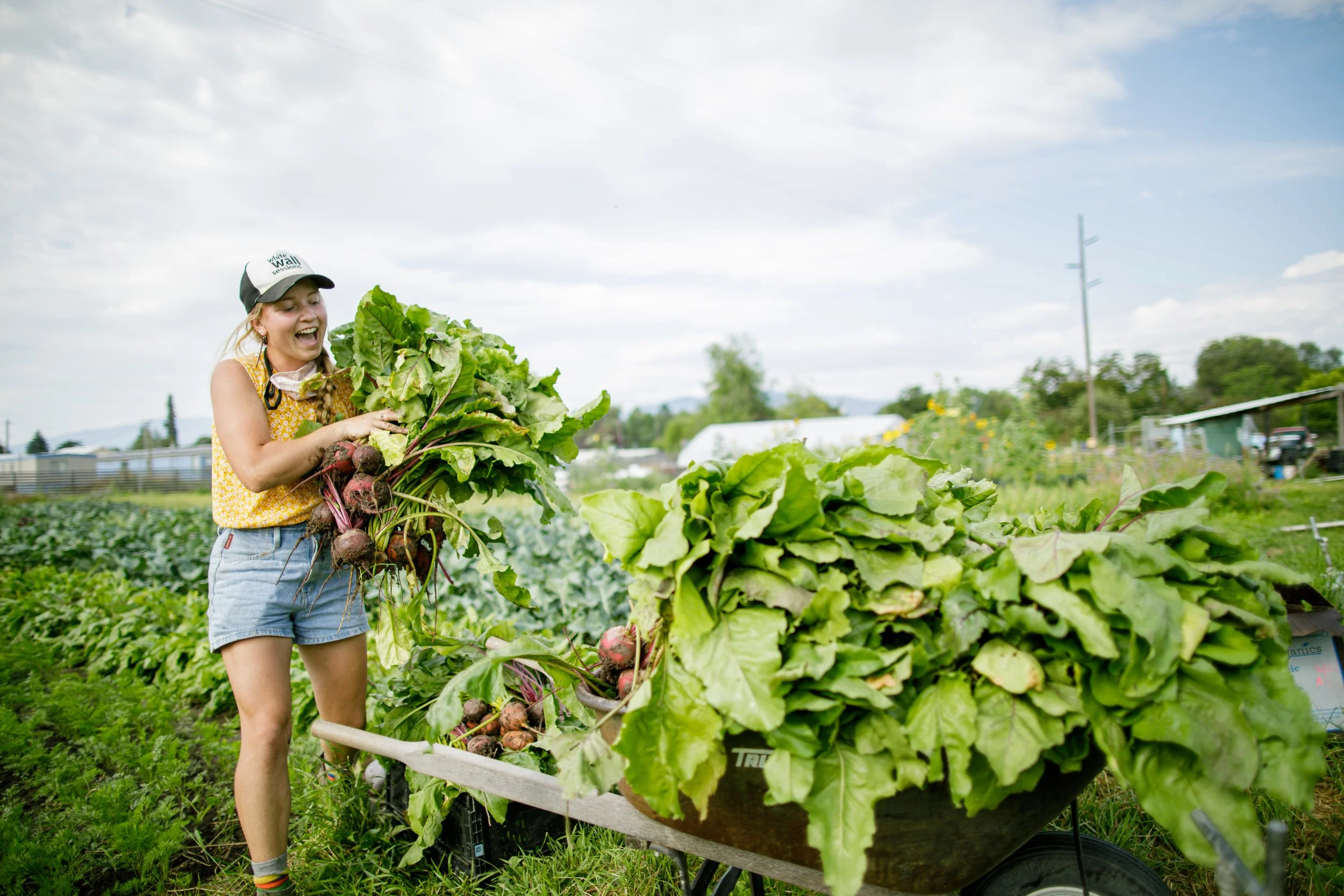Planning Your Garden: Maximizing Space and Harvest
Waiting to spring into planting action, we can do a little extra planning that will have a big impact on our garden’s yield and overall health.
CARE FOR YOUR SOIL
Give your soil some love! Your soil is the foundation for a successful season in the garden.
Understanding soil amendments…
COMPOST is made up of decomposed plant matter and replenishes your soil with a buffet of nutrients that do wonders to rebuild your soil structure, thus increasing water retention and aeration. We recommend a liberal “top-dressing” (covering) of compost on your garden beds each spring.
MANURE refers to animal feces. It is quite potent and a light application can add an extra punch of essential nutrients (especially nitrogen) to your garden. In fact, most manure is so high in nutrients that it can burn your plants if too fresh and nitrogen rich. We recommend two five-gallon buckets worth of manure for a standard 15x15 foot community garden plot. Check with your favorite farmer or gardening expert about good sources of manure in your neck of the woods.
With the nutrient boost from compost and manure, your garden shouldn’t need much, if any, additional fertilizer for the season.
Rotating crops…
Where did you plant your tomatoes last year? Every crop draws different nutrients from the soil, so a yearly mix-up allows the soil to replenish. This rotation also deprives pests and disease of their hosts, thus lessening the impact on your garden.
Most common plant families in the vegetable garden:
Solanaceae, aka solanaceous or nightshade
peppers, tomatoes, potatoes, tomatillos, ground cherries
Brassicaceae, aka cruciferous, mustards or brassica
broccoli, cauliflower, cabbage, Brussel sprouts, mustards, kale, kohlrabi, turnips, rutabaga,
Cucurbitaceae, aka cucurbit or squash
cucumbers, melons, summer squash, winter squash, pumpkins, gourds
Apiaceae, aka umbelliferae or carrot
carrots, parsnips, celery, fennel, parsley, cilantro, caraway, dill, chervil
Liliaceae, aka lily or allium (genus)
onions, garlic, shallots, leeks, chives, asparagus
Asteraceae, aka aster or sunflower
lettuce, endive, escarole, radicchio, artichoke, Jerusalem artichoke, tarragon, chamomile, sunflowers, marigolds, dandelions, yarrow, echinacea
Whenever possible, it is best to allow 2-3 seasons between plantings of the same family. This is particularly important on a larger scale, but can be a helpful tool for boosting soil and plant health in your garden.
Cover Cropping
Prevent erosion, reduce weeds and replenish nutrients all at once by utilizing cover crops in your garden!
Cover cropping may bring to mind the long-term, large-scale perennial crops we use on our farms to allow fields to rest and replenish. But cover crops can be used in much the same way on a smaller scale and over shorter periods of time.
At any point in the season, you can find a cover crop that is right for the job.
Plant frost-tolerant varieties in the spring before your more tender vegetables can be put in the ground.
Plant post-harvest to fill the void and smother weeds.
Plant in your garden pathways to provide a living mulch.
If you choose to cover crop in your garden, ask your farmers and garden experts about the best varieties for your space. Remember: while cover cropping can add a tremendous amount of organic matter into the soil, the crop will need to be cut down, tilled into the soil, and allowed to decompose for 2-4 weeks before planting into that part of your garden.
If cover cropping isn’t an option for you, applying a mulch of straw, leaves, or lawn clippings can provide many of the same benefits.
Maximize your Space
Whether growing in a community garden plot, a raised bed or on acres of farmland, maximizing your growing space is a priority.
Grow Vertically
Growing peas and beans on a trellis is a space-saving trick many gardeners employ without a second thought. So why not encourage our other sprawling veggies to grow upwards? Cucumbers, winter squash and vining, or indeterminate, tomatoes are great candidates. While some plants are natural climbers (e.g. peas, winter squash), others need some assistance to climb successfully(e.g. tomatoes). For these ill-equipped climbers, a bit of string loosely tied around the vine should be enough to support them.
Benefits of growing vertically:
Increased air circulation, thus deterring pests and disease.
Easy, clean harvest, especially with those wily winter squash whose tendency is to creep all the way to the far side of the garden!
Keep in mind that your trellis should be strategically placed so as not to shade out your other plants. If possible, position your structure on the north side of your garden to minimize the impact. Also note, the strength of the trellis should have a direct relationship to the size and weight of the mature crop.
Intercropping
By pairing plants based on their growth rate you can increase your harvest while eliminating space for weeds to take hold. Fast growing plants reach maturity in as few as 30 days (e.g. lettuce, spring radishes and salad turnips) while slow growing plants can take from 60 to 100 days to mature (e.g. broccoli, tomatoes, corn). Intercropping or planting fast and slow growers side by side provides each plant with the space it needs to mature.
MAXIMIZE HARVEST
Succession Planting
On our farms we grow multiple successions for almost every crop. Staggering our plantings allows us to harvest throughout the season.
Carrots are one of many great options for succession planting. They can be sown as early as 2-3 weeks before the last frost of spring and as late as 10 weeks before the first frost of fall. In our climate the planting window for carrots is between early May and early July. Since carrots reach maturity after about 60 days, the first succession of carrots reaches maturity in early July and the last in early September. By planting successions, we can enjoy carrots all summer long and have fall carrots for winter storage!
Lettuce is another great crop to plant in succession. Staggering your plantings in early spring can ensure that you enjoy all that you plant down to the last bite.
Thinning
Thinning is a crucial step for most plants that are seeded directly into the soil. Direct seeding generally entails sowing more seeds than the number of plants intended to increase the chance of germination. Once the seeds have germinated and the seedlings start to establish themselves, thinning creates space for the remaining plants to fully mature. If you want beets 2-3 inches in diameter, you must thin them to 2-3 inches between each plant. Be warned: trying to save every last sprout will lead to stressed plants and a minimal harvest. Rather than thinking of it as waste, add the tender greens to your salad!
A few plants that require thinning and recommended spacing:
Carrots (2-3 inches)
Parsnips (2-4 inches)
Beets (2-4 inches)
Radishes (2-6 inches, depending on variety)
Turnips (2-8 inches, depending on variety)
Bush Beans (4-6 inches)
Corn (8-12 inches)
Your soil is the foundation for a successful season in the garden.
While there are many ways to maximize space and increase your harvest, everything hinges on your soil’s health. Treat it well and reap the benefits!
happy gardening!
ADDITIONAL RESOURCES FROM THE REAL DIRT BLOG:


